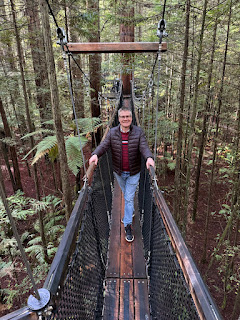On the edge of Rotorua you’ll find a six hectare grove of Californian Coastal Redwoods, part of the Whakarewarewa State Forest Park. The trees were planted in 1901 as part of an experimental program assessing the viability of various exotic tree species for commercial forestry in New Zealand.
Due to the rich volcanic soil, favourable climate and high rainfall in the area, they grew faster in New Zealand than in their native homeland of the United States. In the USA they rely on the west coast’s frequent fog to protect them from dry spells, when rainfall is not consistent. They even create their own ‘rain’ by trapping fog in their huge branches and absorbing the moisture.
In New Zealand, consistent rainfall throughout the year along with vast amounts of sunshine means the Redwoods grow rapidly year round. With the right amount of moisture they can grow almost a metre taller in a year. Currently the largest redwood in Whakarewarewa is 72m tall and 169cm in diameter. That’s approximately two-thirds of its potential full grown height.
On Saturday, Matt, Shelley and I took a day trip to Rotorua to hike through the Redwood forest. I’m currently in New Zealand for a five day weekend, in part to visit my mother’s grave a year after
her death. I flew in on Thursday night, and depart again this evening.
I last visited the Redwoods while on a brief vacation to Taupo with my mother
in 2022. It was my mother’s last vacation before she moved into full time residential care a few months later. Although, at the time, we had no idea it would be her last. It felt somewhat appropriate to revisit the trees while commemorating the first anniversary of her passing.
We walked an extended loop around the grove, before Matt and I went on to try the Treetops Walk. This is a dramatic canopy walkway suspended between the trunks of the redwood trees. It’s 700 metres long, and boasts 28 suspension bridges and 27 platforms that form an aerial circuit through the forest. At its highest point the walkway is suspended about 20 metres above the ground. Understandably, my mother and I never attempted this walk in 2022.
We finished our time in Rotorua with a brief visit to the lake itself. We walked the city’s recently completed lakeside boardwalk, then drove around the lake to enjoy a late lunch at the award-winning Okere Falls cafe. Apparently, it regularly wins the nation’s annual “best toastie” award. We made a quick stop at the falls before returning to The Mount.





















































